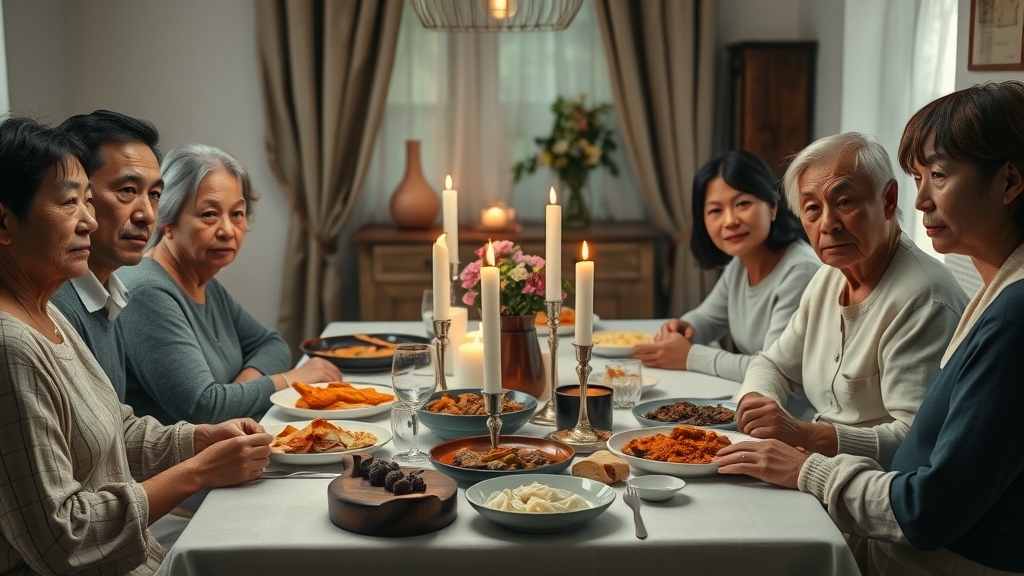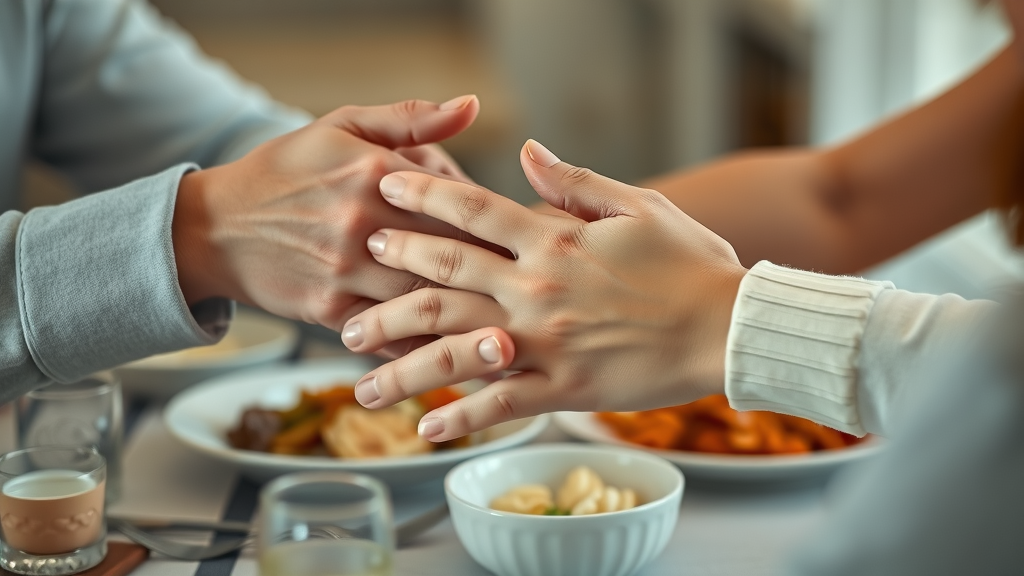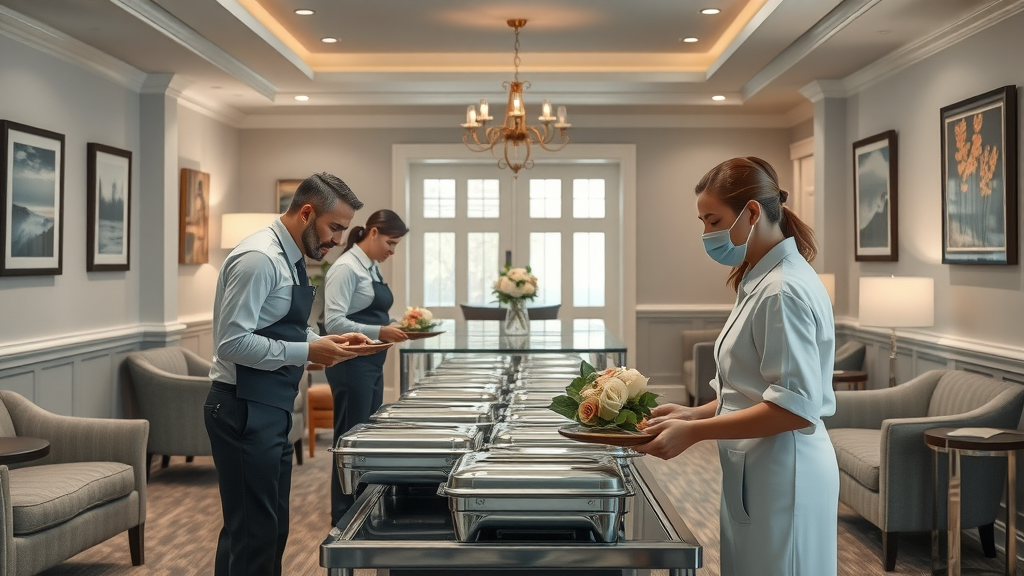Why do we gather around a table after saying a final goodbye? Is this time-honored tradition simply a routine, or does it hold a deeper purpose in how we process grief? In this article, we unravel the essential reasons families, friends, and entire communities come together for a funeral repast —a meal eaten after a funeral service. You'll discover the emotional and cultural significance of this experience and how food plays a healing role during one of life's most challenging moments. If you've ever wondered about the meaning behind sharing a meal after loss, let us guide you through the customs, symbolism, and reasons this tradition remains so meaningful worldwide.
Unveiling Tradition: Why Do We Gather for a Meal After a Funeral?
The act of sharing a meal after a funeral has roots stretching back centuries, transcending borders and belief systems. When asked, what is the purpose of having a dinner after a funeral , the answer is multilayered: such gatherings serve as a communal space for those mourning to find comfort, reconnect, and begin the healing process. After a funeral service , the abrupt stillness of loss often leaves a palpable void—gathering for a meal helps to fill this space with warmth, belonging, and the gentle support of others.
The funeral repast offers a supportive environment where attendees can reflect on the person who has passed, share memories, and express their feelings openly. The meal is not just about eating but about connection, allowing family and friends to begin the healing together. Over plates of cherished dishes or traditional foods, sorrow is softened, and the bonds between those left behind are strengthened.
In today’s world, this tradition has evolved but remains an integral part of saying goodbye. Whether the meal is held at a funeral home , church hall , community center , or a family member 's home, the purpose remains the same: to comfort the bereaved family and to reaffirm the circle of support that surrounds them.

Starting the Conversation: Challenging What We Know About Funeral Repasts
It’s easy to take post-funeral meals for granted as mere custom, but their purpose calls for reflection. Have we lost sight of why we gather? Many assume the funeral repast is just a way to mark the end of a service, but, in reality, it is a profound ritual aiding in the journey from sorrow to solace. The act of sharing food turns the awkwardness of grief into something tangible: support and hope.
Conversations over comfort food help us acknowledge our feelings. Whether laughter or tears fill the room, those gathered can exhibit vulnerability without judgment. By looking beyond rituals, we can appreciate the vital role this tradition plays in our collective healing process—and perhaps, rethink how we approach funeral receptions in our own communities.
For families seeking meaningful ways to honor their loved ones, understanding the nuances of post-funeral gatherings can be invaluable. If you’re interested in practical guidance on creating a supportive environment during these times, you may find additional insights in this resource on helping families honor their loved one , which explores compassionate approaches to remembrance and support.
The Purpose of Having a Dinner After a Funeral: Historical and Cultural Insights
Understanding what is the purpose of having a dinner after a funeral requires a journey through history and across cultures. Post-funeral meals have existed as long as organized ceremonies of mourning themselves. Ancient societies believed that food and drink not only sustained the living but also honored the dead, forming a bridge between worlds.
Different civilizations used funeral feasts to express gratitude for the life lived, while also ensuring proper passage to the afterlife. In some places, communal meals were believed to fortify the surviving family’s strength during mourning. Today, while many customs have modernized, the core intent—bringing people together to honor and remember—remains unchanged.
Funeral homes now often provide spaces specifically for these gatherings, demonstrating their enduring importance in contemporary grief rituals. Across continents and generations, the meal after a funeral continues to serve as a profound marker of community and solace.
How the Funeral Repast Evolved: A Journey Through History
The funeral repast has evolved significantly over time. In ancient Rome, a convivium —a feast held at the graveside—was tradition, offering both a tribute to the deceased and a chance for mourners to unify in grief. Medieval Europe saw the emergence of “arval feasts,” where funeral food was distributed among villagers, often in the hope that charitable acts would benefit the departed’s soul.
By the nineteenth and twentieth centuries, the tradition of the funeral repast gravitated toward the family home, church halls, or community centers. Funeral homes adapted by incorporating reception spaces for mourners. In contemporary American society, these gatherings not only reflect personal preference but are also influenced by religious and cultural background.

Cultural Differences: How Funeral Receptions and Meals Vary Internationally
Around the world, funeral receptions and meals reflect a spectrum of beliefs and values. In Ireland, a “wake” might be filled with storytelling and lively remembrance, with food integral to keeping guests present and comfortable. Jewish culture observes the “seudat havra’ah,” a meal of consolation offered to the bereaved family immediately after burial, focused on plain, nourishing foods.
In the Philippines, traditional wakes often last for days and are marked by communal eating and support. In West African cultures, funeral meals are elaborate affairs, sometimes symbolizing the celebration of the individual's spiritual journey. These differences highlight how funeral repasts are tailored to local customs but universally serve the same healing, communal role.
The United States, a blend of diverse backgrounds, sees both intimate gatherings at home and large receptions at community halls or restaurants following a funeral or memorial service . Each group adds its own meaning and flavor to the tradition, infusing every meal with cultural significance.
Religious Customs: The Role of Meal Eaten After a Funeral Service
Across faiths, a meal eaten after a funeral service takes on both practical and spiritual significance. In Christianity, the “mercy meal” or “repass” functions as a rite where mourners comfort the bereaved family, honor their loved one, and begin the healing process together. For Muslims, it is customary to bring food to the grieving family, reinforcing community support and charitable acts during a difficult time.
Many traditions highlight humility, using simple foods that draw attention to the seriousness of loss rather than extravagance. What remains constant is the intention behind the meal: nurturing both body and soul, offering space for sorrow, and nurturing the connections vital to overcoming loss.
Emotional Significance: The Meal Eaten After a Funeral Service
Few events in life are as emotionally taxing as losing someone we love. The meal eaten after a funeral therefore holds immense emotional significance. It’s here, over familiar dishes and in the warmth of shared silence or gentle laughter, that many begin to process the day’s events and find comfort.
The communal nature of the meal invites openness: stories are told, tears are shed, and hugs are exchanged. In these moments, food plays a role far beyond nourishment, acting as a mediator for healing conversation and genuine connection. For many, these meals provide a chance to honor the deceased by sharing food they loved or dishes from their cultural background, strengthening bonds and fostering acceptance amid grief.
Food, Grief, and Memory: The Healing Power of Sharing a Meal After Loss
After a loved one’s passing, even basic acts like eating can feel overwhelming. Yet, the tradition of sharing a meal can quietly nourish body and spirit, marking an important turning point in the journey through grief. The deliberate act of coming together for funeral food isn’t just about sustenance—it’s about memory, resilience, and the first steps toward acceptance.
Proudly serving a favorite recipe of the person who has passed, or simply gathering around the table they once occupied, helps mourners celebrate the life of their loved one even in their absence. This shared experience can validate the feelings of those present and remind each guest that they are not alone in their loss.

Connecting Family and Community: The Role of Funeral Homes in Hosting Repasts
Modern funeral homes recognize that their role extends beyond the ceremony itself. By providing space and logistical support for funeral receptions, funeral homes help ensure that families can devote their attention to what matters most: remembrance and healing. Offering amenities such as private gathering rooms, catering options, and respectful staff, these venues help transition seamlessly from the formal service to the warmth of sharing food.
For many families, hosting the funeral repast in a neutral, professionally managed funeral home environment lessens the logistical burden during a difficult time. This enables guests to feel welcomed, comfortable, and able to focus entirely on supporting the bereaved family and reconnecting with old friends or distant relatives.
"In every culture, food after a funeral bridges the gap between sorrow and unity."
Planning a Funeral Repast: Etiquette and Modern Practices
Organizing a funeral repast involves more than simply choosing a menu. Etiquette, consideration for the bereaved family, and sensitivity to religious or cultural preferences all play a role. Traditionally, a close family member or friend coordinates the reception, often in consultation with a funeral home .
Modern practices embrace flexibility—receptions might be formal sit-down dinners, casual potlucks, or gatherings at a local restaurant . Regardless of the format, the goal remains the same: to offer a safe and nurturing space for genuine human connection and the gentle start to a new chapter without a loved one.
Who Organizes the Funeral Reception and What to Expect at a Funeral Home
Typically, the immediate family or a designated friend takes on the responsibility of organizing the funeral reception. Funeral homes often assist with logistics, offering packages that may include the use of a reception room, catering coordination, and even help with décor. This support allows mourners and the bereaved family to find comfort without added stress.
When receptions are held at a funeral home, guests can expect a respectful, calm environment—one designed to encourage healing and connection. Options for buffet-style serving, tea and coffee, and a chance to quietly reminisce mark these gatherings. Understanding what to expect can ease anxiety for guests who may be attending a post-funeral meal for the first time.

Essential Elements of a Traditional Funeral Dinner
While each funeral dinner is unique, several elements remain nearly universal: the inclusion of comfort foods, a welcoming atmosphere, spaces for guests to mingle or share stories, and, often, tributes to the loved one lost such as a display of photos or favorite family dishes. These elements are designed to “serve as a communal space” for healing and honoring tradition.
The importance of the funeral repast lies not in the food itself but in the togetherness it fosters. However, menu planning often takes cultural background, family preferences, and religious guidelines into account, leading to an array of beloved recipes and meaningful fare.
Typical Foods Served After a Funeral (Funeral Repast Menu Ideas)
- Baked casseroles (macaroni and cheese, lasagna, baked ziti)
- Sandwich platters (chicken salad, ham, turkey)
- Fried or baked chicken
- Potato salads, green salads, or coleslaw
- Bread and rolls
- Fruit trays and desserts (pies, cakes, cookies)
- Coffee, tea, lemonade, water
Comparison of Funeral Reception Traditions: Food, Rituals, Venue (Home vs. Funeral Home)
| Culture or Region | Typical Food | Rituals | Venue |
|---|---|---|---|
| United States | Comfort food, casseroles, finger foods | Sharing stories, slide shows, favorite recipes | Home, church hall, funeral home |
| Ireland | Tea, sandwiches, hearty stews | Lively storytelling, music | Family home, local pub, hotel |
| Judaism | Bagels, hard-boiled eggs, soup | Meal of consolation ("seudat havra’ah") | Bereaved family’s home |
| Philippines | Rice, stews, sweets | Multiday wakes, communal support | Home, community center |
| West Africa | Rice dishes, grilled meat, plantains | Dancing, music, feasting | Open compound, family yard |
Why Do People Have Dinner After a Funeral?
The central reason people gather for a meal after a funeral is to support each other emotionally and spiritually. In times of loss, sitting down to share food turns a day of sadness into a crucial step in mourning. This gathering helps relatives and friends to process shock or sorrow together, making grief less isolating and honoring the legacy of their loved one through stories, laughter, and remembrance.
Practical considerations also play a role: bereaved families may struggle with day-to-day routines like cooking, so community members relieve this burden. More than just tradition, the meal after a funeral is an act of compassion—one that helps families face an uncertain future with hope and renewed connections.

Understanding the Social and Emotional Reasons for the Meal Eaten After a Funeral
Sharing a meal in the aftermath of grief responds to two fundamental human needs: to find comfort and to reaffirm our sense of belonging. Through the act of sitting together, sharing stories, and finding solace in familiar dishes, mourners can begin the healing process . The funeral repast allows each person to participate in caring for one another and to be cared for themselves.
This social ritual recognizes grief’s power to isolate. By creating a communal space, it helps transform a difficult time into one of hope, where support is visible and tangible. In this way, the meal after a funeral helps all present feel part of a continuing circle of life and love.
Symbolism and the Role of Food in Mourning Rituals
Food is rich with symbolism—each dish at a funeral reception can evoke memories, represent traditions, or honor the deceased’s heritage. In many cultures, specific foods are chosen for their significance: eggs for new beginnings, sweet breads for comfort, or special spiced dishes as a nod to family roots.
The act of sharing food after loss becomes a way to cope collectively, transforming sadness into a celebration of life as much as a marker of its passing. This tradition underscores the belief that while life is fleeting, love and community endure through connection, ritual, and cherished recipes.
Is It Customary to Have a Meal After a Funeral?
In many communities and cultures, it is indeed customary to have a meal after a funeral. This tradition serves as a collective affirmation that the family is not alone. Whether hosted at a funeral home , a church hall , or a relative’s house, the intent is always to extend comfort to the bereaved family, provide an opportunity for guests to honor the departed, and to mark the transition from mourning to acceptance.
While customs vary by region and religious faith, the impulse to gather, share food, and connect is nearly universal—a testament to the deep-seated need to process grief as a community endeavor. The presence of a meal solidifies the ties that support mourners through loss and preserve cherished memories.
Popular Customs Across Different Communities and Funeral Homes
Different communities observe the funeral meal in unique ways. Some families prefer intimate gatherings at home, emphasizing comfort and privacy, while others invite the extended community to a church hall, funeral home, or community center . In the United States, potlucks—where each guest brings a dish—are common and symbolize everyone’s contribution to supporting the grieving family.
Funeral homes frequently offer reception packages and dedicated spaces, reflecting how much value is placed on this ritual. Ultimately, the choice of venue and menu is shaped by cultural background, religious guidance, and individual preference, reinforcing that there is no single “right” way to host a funeral meal.
Why Do People Feast After a Funeral?
People “feast” after a funeral not merely to eat, but to nurture the emotional and social bonds left in the wake of loss. The tradition is less about excess and more about abundance—abundance of support, stories, and love. These moments foster resilience, marking a return to life and routine while keeping the memory of the person who has passed alive.
Feasting together allows communities to express solidarity. In times of loss, traditional roles dissolve and everyone is a mourner, united in the power of breaking bread together to heal, remember, and celebrate the life that was lived.
Rituals of Remembrance: How the Funeral Repast Bonds Mourners
The funeral repast is more than a meal; it’s a delicate balance of celebration and sorrow where bonds are rekindled and new patterns of support are forged. Attendees share a meal, reminisce about happier times, and pledge ongoing support to the bereaved family. This act deepens relationships and marks a shared commitment to remember and to heal.
Whether it’s through a cherished family recipe, communal toasts, or storytelling, rituals like these help everyone present to move forward with strength and understanding. The repast serves as a bridge from the pain of loss to the comfort of community.
What Does the Bible Say About Eating After a Funeral?
The Bible references funeral meals as acts of compassion and community support. In both the Old and New Testaments, sharing a meal after loss is depicted as a gesture of solidarity, providing sustenance for the bereaved and honoring those who have passed. These traditions reinforce the role of food as a tangible expression of love and remembrance during mourning.
Christian funeral customs today often reflect these scriptural teachings, emphasizing the importance of coming together to comfort those in grief, to pray, and to begin anew with the help of faith and fellowship.

Scriptural References to Funeral Feasts and Sharing a Meal
Scripture highlights several examples of meals shared in the wake of loss. In the Book of Job (Job 42:11), friends and relatives bring Job food in his time of loss, demonstrating support and compassion. Ezekiel 24:17 references “bread of mourners” as part of ritual mourning, and 2 Samuel 3:35 notes that people urge David to eat after the death of Abner, showing caring during a period of deep grief.
Such references underpin the longstanding practice of eating after a funeral as a means of healing, comfort, and maintaining community ties. For many Christians, these passages provide spiritual justification for the funeral repast tradition.
FAQs About the Meal Eaten After a Funeral
Can Anyone Attend the Funeral Reception at the Funeral Home?
Generally, funeral receptions are open to all mourners, though sometimes they may be private at the family’s request or limited to close family and friends. If unsure, it’s respectful to ask the bereaved family or the funeral home staff for guidance. Gathering together helps honor the person who has passed and supports those grieving.
How Long Does the Funeral Repast Typically Last?
A traditional funeral repast lasts between one and three hours, depending on the community, venue, and number of guests. The focus is on comfort, relaxation, and remembrance, so there’s no strict timetable—guests usually stay as long as the family feels comfortable hosting or as meals and conversations continue.
Are There Alternatives to Traditional Funeral Dinners?
Yes, many families choose alternatives such as afternoon teas, dessert receptions, remembrance brunches, or even virtual gatherings. The format can reflect the personality of the departed and the preferences of the bereaved family while still providing the healing benefits of communal support and shared remembrance.
Key Lessons About the Purpose of Having a Dinner After a Funeral
Reflecting on the Healing Power of Breaking Bread Together
Breaking bread after a funeral serves as a vital act of community, memory, and healing. It reminds us that while grief can be overwhelming, sharing a meal can gently guide us toward comfort, support, and new beginnings.
This tradition, rich in history and meaning, shows us that food is not just nourishment—it’s a symbol of love and continuity, ensuring no one grieves alone, and that every story, every life, is honored long after the service ends.
Honoring the Tradition: Moving Forward with Compassion and Understanding
Embrace post-funeral meals as opportunities to comfort, connect, and heal. Approach each gathering with compassion and honor the tradition knowing you’re participating in one of humanity’s most meaningful rituals.
If you’re inspired to deepen your understanding of how families can honor loved ones beyond the meal, consider exploring broader perspectives on remembrance and support. Discovering new ways to celebrate life and foster healing can help you create lasting, meaningful tributes that extend well beyond the day of the funeral. For more thoughtful approaches and advanced insights, visit this guide to helping families honor their loved one and continue your journey toward compassionate remembrance.
Sharing a meal after a funeral, often referred to as a repast, serves as a vital tradition across various cultures and communities. This gathering provides mourners with an opportunity to come together, share memories, and offer mutual support in a more relaxed setting following the formal funeral service. The repast allows attendees to reflect on the deceased’s life, fostering emotional connection and healing through communal sharing. ( en.wikipedia.org )
The significance of the funeral meal extends beyond mere sustenance; it acts as a comforting ritual that honors the deceased while strengthening the bonds among those grieving. In many traditions, such gatherings symbolize community support and solidarity during mourning, providing a space for individuals to express their grief collectively and begin the healing process together. ( belgenmezar.com )
Understanding the purpose and cultural importance of the funeral repast can offer valuable insights into how different societies navigate the complexities of loss and remembrance. By participating in these communal meals, individuals find solace and reaffirm the enduring connections that support them through their grief.
 Add Row
Add Row 

 Add
Add 


Write A Comment